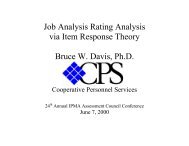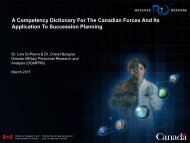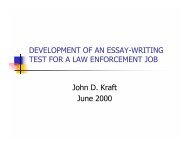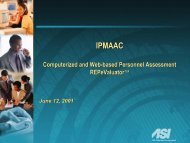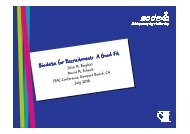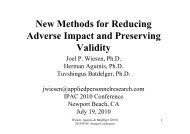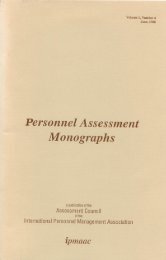The Standards for Educational and Psychological Testing ... - IPAC
The Standards for Educational and Psychological Testing ... - IPAC
The Standards for Educational and Psychological Testing ... - IPAC
Create successful ePaper yourself
Turn your PDF publications into a flip-book with our unique Google optimized e-Paper software.
<strong>The</strong> <strong>St<strong>and</strong>ards</strong> <strong>for</strong> <strong>Educational</strong> <strong>and</strong><strong>Psychological</strong> <strong>Testing</strong>: Zugzwang<strong>for</strong> the Practicing Professional?Prepared <strong>for</strong>:IPMAAC<strong>The</strong> International Personnel ManagementAssociation Assessment CouncilNewport Beach, Cali<strong>for</strong>niaJune 12, 2001Paul D. KaiserKristine Smith
What the heck is Zugzwang <strong>and</strong>how can I get me some?◆ It is a paradox of chess that the right to movecan occasionally become an onerous obligation.◆ Chess players know such situations aszugzwangs -- "zugzwang” being the German<strong>for</strong> "obligation to move.”◆ Simple zugzwang - one side can suffer fromhaving the move.◆ Mutual zugzwang - neither side can movewithout worsening its position.
Highlights of the <strong>St<strong>and</strong>ards</strong> <strong>for</strong><strong>Educational</strong> <strong>and</strong> <strong>Psychological</strong> <strong>Testing</strong>Three organizations were responsible <strong>for</strong>the development of the 1999 <strong>St<strong>and</strong>ards</strong>◆ American <strong>Educational</strong> Research Association(AERA)◆ National Council on Measurement in Education(NCME)◆ American <strong>Psychological</strong> Association (APA)
<strong>St<strong>and</strong>ards</strong> - 1985 <strong>and</strong> 1999 versions<strong>The</strong> 1999 <strong>St<strong>and</strong>ards</strong>◆ has more background material, a greater number ofst<strong>and</strong>ards, <strong>and</strong> an exp<strong>and</strong>ed glossary <strong>and</strong> index◆ reflects changes in federal law <strong>and</strong> measurementtrends affecting validity, etc.◆ addresses professional <strong>and</strong> technical issues of testdevelopment <strong>and</strong> use
<strong>The</strong> Purpose of the <strong>St<strong>and</strong>ards</strong>◆ to promote the sound <strong>and</strong> ethical use of tests◆ to provide assessment professionals withguidelines <strong>for</strong> the evaluation, development, <strong>and</strong>use of testing instruments◆ to provide a frame of reference <strong>for</strong> addressingrelevant issues
<strong>The</strong> <strong>St<strong>and</strong>ards</strong> are not◆ legislation or law◆ a ‘checklist’ <strong>for</strong> evaluating the acceptability of atest or its use
Overview - Organization <strong>and</strong>Content Part OneTest Construction, Evaluation, & Documentation◆ Validity◆ Reliability <strong>and</strong> Errors of Measurement◆ Test Development <strong>and</strong> Revision◆ Scales, Norms, <strong>and</strong> Score Comparability◆ Test Administration, Scoring, <strong>and</strong> Reporting◆ Supporting Documentation <strong>for</strong> Tests
Overview - Organization <strong>and</strong>Content Part TwoFairness in <strong>Testing</strong>◆ Fairness in <strong>Testing</strong> <strong>and</strong> Test Use◆ <strong>The</strong> Rights <strong>and</strong> Responsibilities of Test Takers◆ <strong>Testing</strong> Individuals of Diverse LinguisticBackgrounds◆ <strong>Testing</strong> Individuals with Disabilities
Overview - Organization <strong>and</strong>Content Part Three<strong>Testing</strong> Applications◆ <strong>The</strong> Responsibilities of Test Users◆ <strong>Psychological</strong> <strong>Testing</strong> <strong>and</strong> Assessment◆ <strong>Educational</strong> <strong>Testing</strong> <strong>and</strong> Assessment◆ <strong>Testing</strong> in Employment <strong>and</strong> Credentialing◆ <strong>Testing</strong> in Program Evaluation <strong>and</strong> Public Policy
Chapter 1—Validity1<strong>The</strong> Grail--testing pointless without it◆ refers to the degree to which evidence <strong>and</strong> theorysupport the interpretations of test scores entailedby proposed uses of tests◆ the most fundamental consideration in developing<strong>and</strong> evaluating tests
Lines of Validity Evidence<strong>The</strong> <strong>St<strong>and</strong>ards</strong> move away from languageabout types of validity to lines of validityevidence.◆ test content◆ response/scoring processes◆ internal structure of test◆ relationships to other variables
<strong>The</strong> <strong>St<strong>and</strong>ards</strong> on Validity Focus◆ on the obligations of the test developer to users,examinees, <strong>and</strong> other testing practitioners◆ on user obligations to examinees
Developers owe usersEnough in<strong>for</strong>mation to make judgments aboutthe appropriateness of their interpretation oftest scores <strong>for</strong> their intended use(s)◆ population(s) <strong>for</strong> which test is appropriate◆ constructs tested◆ uses/interpretations NOT intended orrecommended
Developers owe users◆ content descriptions, domains, criticality◆ qualifications of experts/judges/raters◆ rating/scoring procedures◆ population/situation variables involved invalidation
Developers owe users◆ quality of criteria◆ statistical adjustments made◆ relation of local situation to metaanalyticvariables used
Developers owe examineesreasonable assurance that tests will not beused improperly◆ use of content/constructs appropriate torecommended <strong>and</strong>/or intended use(s)◆ adequate warning to users against uses NOTrecommended or intended◆ accuracy in criterion validation, whenper<strong>for</strong>med◆ investigation of unintended/unexpectedoutcomes (e.g., DIF)
Developers owe other practitionerssound practices <strong>and</strong> evidence, accurately<strong>and</strong> adequately described◆ validation samples in relevant detail◆ processes/procedures in adequate detail◆ criteria adequately described◆ statistical evidence <strong>and</strong> descriptions of anyadjustments
Users owe examineesappropriate use(s) of tests◆ following test developers’ guidelines onusage of the test◆ validating new uses of a test
Obligations under <strong>St<strong>and</strong>ards</strong>Developer should help User:◆ use test results properly; ‘head off’ obviousimproper uses◆ underst<strong>and</strong> test’s value, limitations◆ underst<strong>and</strong> degree to which test is ‘proven’User owes Examinees:◆ Proper, fair use/interpretation◆ Avoiding misuse of test
Chapter 2—Reliability2◆ <strong>The</strong> test - a system <strong>for</strong> collecting examples of anindividual's work or behaviors in a particulararea.◆ A scoring procedure - enables the examiner toquantify, evaluate, <strong>and</strong> interpret the behavior orwork samples.
Reliability◆ Reliability refers to the consistency of suchmeasurements when the testing procedure isrepeated on a population of individuals orgroups.◆ <strong>The</strong> <strong>St<strong>and</strong>ards</strong> address almost exclusively thetest developers’ obligations to providein<strong>for</strong>mation to test users.
ReliabilityConsistency, replicability of measurement onrepeated use with individuals or groups◆ correlation coefficient◆ SEM◆ interrater reliability
Reliability — Developers Owe UsersTo enable the users to make in<strong>for</strong>medjudgments about the test <strong>and</strong>interpretations of test scores:◆ estimates of the reliability <strong>and</strong> SEM of allscores to be interpreted◆ estimates of SEM in both original scale units<strong>and</strong> the units of any derived scores◆ method(s) used to compute reliability
Reliability — Developers Owe Users◆ statistical adjustments made to reliabilityestimates◆ composite reliability estimates <strong>for</strong> multi-factortests◆ estimates of inter-rater reliability, when relevant◆ estimate of “local” reliability of “locally” scoredtest◆ estimate replicability of “categorical”classifications (e.g., pass/fail)
Obligations under <strong>St<strong>and</strong>ards</strong>Developer to User:◆ accurate <strong>and</strong> appropriate reliability estimate◆ report how estimated, including adjustmentsUser to Examinee:◆ do not base decisions on unreliable test
Chapter 3—Test 3Development <strong>and</strong>RevisionTest Development◆ Process of producing a measure of someaspect of an individual's KSA’s◆ Guided by the stated purpose of the test
Test Development <strong>and</strong> Revision◆ Primer on how to develop tests◆ Definitions of terms <strong>and</strong> concepts involved intest development (e.g., norm/criterionreferencing, holistic scoring)
Test Development <strong>and</strong> Revision<strong>St<strong>and</strong>ards</strong> focus on◆ Stating the purpose◆ Developing a framework◆ Developing test specifications◆ Developing <strong>and</strong> evaluating items◆ Assembling the test
Test Development <strong>and</strong> Revision◆ Document what you do◆ Describe the purpose of the test <strong>and</strong> thedomains to be covered (i.e., constructs, SKAPs)◆ Document the test specifications◆ Have SMEs review the test specifications <strong>and</strong>test items
Test Development <strong>and</strong> Revision◆ Document procedures <strong>for</strong> interpreting scores◆ Document procedures used to write, review,pretest, <strong>and</strong> select items◆ Where scores are derived from differentialweighting of test items, document therationale <strong>and</strong> process used
Test Development <strong>and</strong> Revision◆ Document rating scales <strong>for</strong> constructedresponse (i.e., short answer, essay, <strong>and</strong>per<strong>for</strong>mance) tests.◆ Where tests have time limits, examine theextent to which speed is a factor in testper<strong>for</strong>mance.◆ Indicate clearly to test takers when a test is<strong>for</strong> research purposes only.
Obligations under <strong>St<strong>and</strong>ards</strong>Document everything involved◆ development of test specifications◆ SME review of specifications <strong>and</strong> items◆ procedures <strong>for</strong> interpreting scores◆ procedures to write, pretest, select items◆ rationale <strong>and</strong> process <strong>for</strong> any weightings◆ rating scales <strong>for</strong> constructed responses◆ alternate <strong>for</strong>m specifications meet originals
Chapter 4—Scales, 4Norms, <strong>and</strong>Score Comparability◆ Focus of <strong>St<strong>and</strong>ards</strong> is on converting raw scores tosome <strong>for</strong>m of scaled score in order to enhance thescores’ interpretability <strong>and</strong> meaning.◆ Scaling a test means choosing a scoring <strong>for</strong>mulaor set of <strong>for</strong>mulas to accomplish the conversion.
Scales, Norms, <strong>and</strong> ScoreComparability◆ Converting raw to scaled scores◆ Terms <strong>and</strong> concepts in scaling, equating, etc.◆ Bases <strong>for</strong> passpoints <strong>and</strong> b<strong>and</strong>s◆ Alternate <strong>for</strong>ms
Scales, Norms, <strong>and</strong> ScoreComparability◆ Raw scoreSome Definitions◆ Scaled or derived score◆ <strong>St<strong>and</strong>ards</strong> or cut scores
Scales, Norms, <strong>and</strong> ScoreComparabilityBasis <strong>for</strong> cut scores◆ number to be hired or promoted◆ empirical research◆ SME judgment (e.g., Angoff, Nedelsky)◆ Norm-referenced or Criterion-referenced
Scales, Norms, <strong>and</strong> ScoreComparability◆ Alternate <strong>for</strong>ms◆ Equating◆ Adaptive tests◆ Linkage, calibration, concordance,projection, moderation, <strong>and</strong> anchoring
Scales, Norms, <strong>and</strong> ScoreComparability◆ Clearly explain scales used to convert scores◆ If specific misinterpretations of score scalesare likely, <strong>for</strong>ewarn the test users◆ Describe norming population <strong>and</strong> samplesclearly◆ When norms are used to characterize groups(in contrast to individuals), the statistics usedto describe the group need to be clearlyexplained.
Scales, Norms, <strong>and</strong> ScoreComparability◆ Clearly explain the rationale <strong>for</strong> thecriterion-referenced score interpretation.◆ Explain <strong>and</strong> provide evidence to support theequivalence of scores on alternate <strong>for</strong>ms.
Obligations under <strong>St<strong>and</strong>ards</strong>◆ Explain scales <strong>and</strong> meanings of scaled scores◆ Explain interpretations of any scores◆ Describe norming populations, process◆ Explain rationale <strong>for</strong> criterion-referencedinterpretation◆ Document rationale <strong>for</strong> cut scores/b<strong>and</strong>s◆ Let SMEs work as SMEs
Chapter 5–Test 5Administration,Scoring, <strong>and</strong> Reporting◆ St<strong>and</strong>ardized instructions/procedures increasereliability, score interpretability◆ St<strong>and</strong>ardization <strong>and</strong> test security helps insure testfairness◆ Disability may require modified administration◆ Examinees should be given enough in<strong>for</strong>mation tointerpret their scores
Obligations under <strong>St<strong>and</strong>ards</strong>◆ Test administration should be st<strong>and</strong>ardized◆ Modifications or disruptions of administrationprocedures or scoring should be documented◆ Test takers should be in<strong>for</strong>med of procedures <strong>for</strong>requesting <strong>and</strong> receiving accommodations inadvance of testing◆ <strong>The</strong> testing environment should furnish reasonablecom<strong>for</strong>t with minimal distractions
Obligations under <strong>St<strong>and</strong>ards</strong>◆ Instructions should indicate how to makeresponses <strong>and</strong> use unfamiliar equipment◆ Eliminate opportunities <strong>for</strong> test takers to attainscores by fraudulent means◆ Test users are responsible <strong>for</strong> protecting thesecurity of test materials at all times
Obligations under <strong>St<strong>and</strong>ards</strong>◆ Protect the confidential nature of the reportedscores◆ Material errors found in test scores should becorrected ASAP◆ Protect test security; prevent cheating, fraud◆ Score accurately
Chapter 6—Supporting6Documentation <strong>for</strong> Tests◆ Objective is in<strong>for</strong>med decisions by user◆ Primary communication channel to users◆ Should be complete, accurate, current, clear◆ Specify nature of test, use, development process,scoring, interpretation, validity, reliability,scaling, norming, administration
Obligations under <strong>St<strong>and</strong>ards</strong>◆ Develop, as needed, appropriate user guides◆ Document all studies <strong>and</strong> analytical procedures◆ Keep documentation on all job analysisactivities <strong>and</strong> test development steps◆ Document the item selection procedures (Jobexpert use, pre-testing, etc.) used <strong>for</strong> the test.
Obligations under <strong>St<strong>and</strong>ards</strong>◆ Keep files of job specifications, announcements(minimum qualifications, duties statements,etc.) <strong>for</strong> the test.◆ Keep documentation on all statistical analyses<strong>and</strong> passpoint setting procedures per<strong>for</strong>med onthe test.◆ Keep files of any specific studies done on thetest.
Obligations under <strong>St<strong>and</strong>ards</strong>◆ Keep files of ethnic <strong>and</strong> gender item analysis,etc.◆ If the separate answer sheet response method isused <strong>and</strong> computerized tests are also developed,determine if scores are interchangeable or ifthe response method used affects scores◆ Test booklets <strong>and</strong> all test related analysismaterials should be properly <strong>and</strong> accuratelydated.
Obligations under <strong>St<strong>and</strong>ards</strong>◆ documentation underst<strong>and</strong>able by user◆ document uses <strong>and</strong> warn on misuses◆ give reliability, validity data, if any◆ specify administrator qualifications◆ prove alternate <strong>for</strong>ms really are◆ support interpretations
Chapter 7–Fairness 7in <strong>Testing</strong> <strong>and</strong>Test UseFocus of <strong>St<strong>and</strong>ards</strong> is on◆ responsibilities of those who make, use, <strong>and</strong>interpret tests◆ those aspects that are characterized by somemeasure of professional <strong>and</strong> technical consensus
Fairness in <strong>Testing</strong> <strong>and</strong> Test Use4 characterizations of fairness1. no bias2. equitable treatment in process3. equal outcomes4. equal opportunity to learn content
Fairness in <strong>Testing</strong> <strong>and</strong> Test Use◆ bias: construct irrelevancies which lower orraise scores <strong>for</strong> identifiable groups◆ absolute fairness to all impossible◆ (3) almost entirely repudiated◆ Differential Item Functioning (DIF)
Fairness in <strong>Testing</strong> <strong>and</strong> Test Use◆ Pre-Test◆ Post-Test (DIF)Sensitivity Review Panels
Obligations under <strong>St<strong>and</strong>ards</strong>◆ if scores differ, get validity evidence <strong>for</strong> eachsubgroup◆ only use test <strong>for</strong> group if valid <strong>for</strong> group◆ conduct sensitivity reviews
Obligations under <strong>St<strong>and</strong>ards</strong>◆ conduct DIF studies when feasible◆ keep verbal level to minimum valid level◆ check that group differences are not based on contentirrelevancies or construct under-representation◆ equitable treatment during testing
Chapter 8–<strong>The</strong> 8Rights <strong>and</strong>Responsibilities of Test Takers◆ Fairness issues unique to the interests of theindividual test taker◆ Test takers have responsibilities
<strong>The</strong> Rights <strong>and</strong> Responsibilities ofTest Takers◆ Fair treatment promotes validity◆ Test takers should get info on: nature of test,use, confidentiality, available accommodations◆ Test takers have responsibilities to: prepare <strong>for</strong>test, follow directions, answer honestly, notcheat, not steal material, not violate testsecurity
<strong>The</strong> Rights <strong>and</strong> Responsibilities ofTest Takers◆ In<strong>for</strong>mation about the test that is available to anytest taker should be available to all test takers◆ Test takers should be in<strong>for</strong>med about test content,including subject area, topics covered, <strong>and</strong> item<strong>for</strong>mats◆ Scores of individuals should be kept confidential
<strong>The</strong> Rights <strong>and</strong> Responsibilities ofTest Takers◆ Data files should be adequately protected fromimproper disclosure◆ Test takers should be made aware that any<strong>for</strong>m of cheating is inappropriate <strong>and</strong> that suchbehavior may result in sanctions◆ Any <strong>for</strong>m of cheating or behavior should beinvestigated promptly
Obligations under <strong>St<strong>and</strong>ards</strong>◆ Make same in<strong>for</strong>mation on test available to all◆ In<strong>for</strong>m test takers of content <strong>and</strong> test <strong>for</strong>mat◆ Maintain confidentiality◆ Warn of consequences of cheating◆ Investigate possible cheating, fast, fairly, withappeal available <strong>for</strong> disqualification
Chapter 9–<strong>Testing</strong> 9Individuals ofDiverse Linguistic Backgrounds◆ Centers on translated tests◆ Any test using language is partly a test oflanguage skill◆ Lack of it may invalidate measure of KSA◆ OK to test in language <strong>and</strong> at level needed <strong>for</strong> job◆ Similar issues involved in testing some disabledc<strong>and</strong>idates
<strong>Testing</strong> Individuals of DiverseLinguistic Backgrounds◆ Design tests to reduce threats to the reliability<strong>and</strong> validity of test score inferences that mayarise from language differences.◆ Generally, the test should be administered in thetest taker's most proficient language, unlessproficiency in the less proficient language is partof the assessment.
<strong>Testing</strong> Individuals of DiverseLinguistic Backgrounds◆ Bilingual individuals can vary considerably intheir ability to speak, write, <strong>and</strong> read in eachlanguage.◆ <strong>The</strong>se abilities are affected by the social orfunctional situations of communication.
<strong>Testing</strong> Individuals of DiverseLinguistic Backgrounds◆ Language level needed <strong>for</strong> the test should notexceed the level needed to meet workrequirements.◆ Issues associated with bilingual testing are alsorelevant to testing individuals who have uniquelinguistic characteristics due to disabilities suchas deafness <strong>and</strong>/or blindness.
Obligations under <strong>St<strong>and</strong>ards</strong>◆ Design test to reduce invalidity based on languagedifferences◆ Give test in taker’s best language, unless languageis part of assessment◆ If modified test scores comparable to original, donot “flag” modified score◆ Test language level not to exceed job need
Chapter 10—<strong>Testing</strong> Individualswith Disabilities◆ Modification to test <strong>for</strong>mat, response <strong>for</strong>mat,timing, setting, content◆ Modification to eliminate construct-irrelevantdifferences in per<strong>for</strong>mance◆ Modification should not change construct◆ Modification should not put those with modifiedtest at undue advantage over “regular” test takers
<strong>Testing</strong> Individuals with DisabilitiesDefinitions◆ Individuals with Disabilities◆ Accommodation
<strong>Testing</strong> Individuals with DisabilitiesModification not appropriate under variety ofcircumstances◆ If test designed to assess essential skills, <strong>and</strong> wouldfundamentally alter construct being measured◆ Disability such that would not influenceper<strong>for</strong>mance on test◆ Requested modification exceeds “reasonableaccommodation” <strong>for</strong> the disability
<strong>Testing</strong> Individuals with DisabilitiesAlter the medium to present test instructions◆ For visual impairments (e.g.—Braille, large print,computer administered oversize computerscreens, larger fonts)◆ For hearing disability (e.g.—sign communicationor writing)
<strong>Testing</strong> Individuals with DisabilitiesModifying Response Format Allow use of preferred communication modalitySevere language deficit – can point to responseManual disability – amanuensis, tape recorder,computer keyboard, Braillewriter
<strong>Testing</strong> Individuals with DisabilitiesModifying Timing◆ Breaks during testing◆ Extended time◆ Extended testing over several days
<strong>Testing</strong> Individuals with DisabilitiesModifying Test Setting◆ Individualized testing◆ Location wheelchair accessible◆ Tables <strong>and</strong> chairs◆ Altered lighting conditions
<strong>Testing</strong> Individuals with DisabilitiesUsing only Portions of Test◆ Waive oral test <strong>for</strong> hearing disabled◆ Substitute Tests or Alternate Assessments
Obligations under <strong>St<strong>and</strong>ards</strong>◆ Take steps to ensure score differences based onconstruct, not disability◆ Have knowledge/expertise on test/disabilityinteraction◆ Pilot test◆ Document modifications, effects
Obligations under <strong>St<strong>and</strong>ards</strong>◆ Set empirical time limits, etc.◆ Validate on test takers with disability◆ Use an appropriate modification◆ Alert users to relevant changes only
Chapter 11—<strong>The</strong> Responsibilities ofTest Users◆ Primary focus is to protect those tested fromimproper use of tests◆ Aimed at users who select, give, apply tests◆ Covers issues <strong>for</strong> users to consider whenper<strong>for</strong>ming those activities
Obligations under <strong>St<strong>and</strong>ards</strong>◆ Use appropriate test◆ Allow only trained persons to pick, give,interpret tests◆ Know how test adds value to decisions◆ Give timely, underst<strong>and</strong>able results toexaminees
Chapter 12—<strong>Psychological</strong> <strong>Testing</strong><strong>and</strong> Assessment◆ diagnosisFour uses of psychological testing◆ intervention planning & evaluation◆ legal & government decisions◆ personal awareness, etc.
<strong>Psychological</strong> <strong>Testing</strong> <strong>and</strong>Assessment<strong>Psychological</strong> testing is used inemployment testing to◆ answer specific questions about a client’spsychological functioning during a particular timeinterval◆ predict a client’s psychological functioning in thefuture
Obligations under <strong>St<strong>and</strong>ards</strong>◆ Users--stay in areas of competence◆ “Know your tests,” pick right one(s)◆ If combination of tests, use ones that “work”together
Obligations under <strong>St<strong>and</strong>ards</strong>◆ For differential diagnosis, test mustdifferentiate◆ Provide pretest in<strong>for</strong>mation <strong>and</strong> results◆ Train administrators <strong>and</strong> scorers◆ Maintain security <strong>and</strong> confidentiality
Chapter 13—<strong>Educational</strong> <strong>Testing</strong><strong>and</strong> Assessment◆ <strong>Testing</strong> in <strong>for</strong>mal educational settings◆ 3 areas: routine, system-wide; selection <strong>for</strong>higher ed.; individualized/special◆ <strong>Educational</strong> tests: plot KSAs vs. goals◆ Stakes: effects on test-takers; the higher thestakes, the more evidence of quality needed
Obligations under <strong>St<strong>and</strong>ards</strong>◆ Specify uses of m<strong>and</strong>ated tests◆ Show quality of multiuse tests <strong>for</strong> uses◆ Norm locally◆ Give students opportunity to learn, <strong>and</strong> to beretested if stakes high
Obligations under <strong>St<strong>and</strong>ards</strong>◆ Validate placement or promotion tests◆ Have qualified monitors, supervisors, scoreinterpreters◆ Test preparatioin should not affect validity◆ Score reports: test date, SEM, interpretation.
Chapter 14—<strong>Testing</strong> inEmployment <strong>and</strong> Credentialing◆ In employment: selection, placement, promotion◆ Context: c<strong>and</strong>idate pool, screening in or out, soledeterminer or not, applicant count, selection ratio◆ Credentialing: st<strong>and</strong>ards <strong>for</strong> practitioner◆ Test should be valid, cut score appropriate
<strong>Testing</strong> in Employment <strong>and</strong>CredentialingProfessional or Occupational Credentialing◆ Tests are intended to identifying practitionerswho have met particular st<strong>and</strong>ards.◆ Qualifications typically include educationalrequirements, supervised experience, <strong>and</strong>attainment of a passing score on tests.
<strong>Testing</strong> in Employment <strong>and</strong>Credentialing◆ Test design requires a definition of the occupationso that persons can be clearly identified as engagingin the activity.◆ Validation strategies rely primarily on contentrelatedevidence.◆ Verifying the appropriateness of the cut score is thecritical element
<strong>Testing</strong> in Employment <strong>and</strong>CredentialingWhen designing <strong>and</strong> evaluating anemployment test, contextual features suchas the following should be considered:◆ internal vs. external c<strong>and</strong>idate pool◆ untrained vs. specialized jobs
<strong>Testing</strong> in Employment <strong>and</strong>Credentialing◆ short-term vs. long-term focus◆ screen in vs. screen out◆ mechanical vs. judgmental decision making◆ size of applicant pool relative to the number ofjob openings
Obligations under <strong>St<strong>and</strong>ards</strong>◆ Validation: congruent with testing objectives◆ Important work behaviors as criteria◆ Base content evidence on thorough, explicitdefinition of domain, from JA◆ Credentials: set cut score <strong>for</strong> per<strong>for</strong>manceneeded, not numbers
Chapter 15—<strong>Testing</strong> in ProgramEvaluation <strong>and</strong> Public Policy◆ Program Evaluation: process to judge need <strong>for</strong>,value of program◆ Typically infers from tests designed <strong>for</strong> otheruses, so is secondary data analysis◆ Tests so used should meet <strong>St<strong>and</strong>ards</strong>
Obligations under <strong>St<strong>and</strong>ards</strong>◆ Show quality of multiuse tests <strong>for</strong> each◆ Define <strong>and</strong> validate any change scores◆ Monitor impact, minimize negatives ofm<strong>and</strong>ated tests; maintain test integrity◆ In<strong>for</strong>m legitimately interested: admin,scoring, score retention, release conditions◆ Prevent misinterpretation of scores



